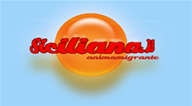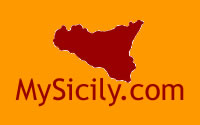.jpg) |
| |
|
|
|
|
|
|
WELCOME
TO MARSALA
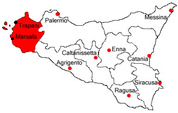 The
City The
City
With a population of 80,000, Marsala is the fifth-largest
Sicilian municipality in number, and certainly among the
more interesting, from the archeological and monumental
points of view, as well as in landscape.
The territory of Marsala consists of more than one hundred
districts, and its economy is based mostly on agriculture,
with more than one million hectoliters of wine produced
each year, as well as a large quantity of vegetables
and flowers. Marsala wine (Link su Vino Marsala), in fact,
is the product that put Marsala on the map, and was a leading
factor in the development of the city’s economy.
Marsala sits on the westernmost point of the island of
Sicily, jutting into the ocean at the Boeo Cape, overlooking
the archipelago of the Egadi Islands and beyond, toward
Africa. The sea and its 14 Km of coastline along Marsala
are among the city’s principal resources. Of particular
interest is the Stagnone Lagoon, a nature reserve off which
the islands, salt marshes, and windmills reflect.
|
|
|
|
|
|
A
Brief History of Marsala
Whether you arrive in Marsala from Trapani (the province in
which the city lies) to the north, or Mazara del 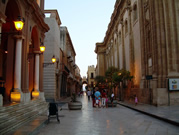 Vallo
to the south, you will notice a sign that reads, ‘Welcome
to Marsala, the City of Wine”. Indeed, Marsala is Sicily’s
largest wine-producing center, best known for its sweet dessert
wine. An elegant town of stately Baroque-era buildings and
quaint shops, Marsala was founded by the Phoenicians upon
their escape from Mozia, a small island in the Stagnone Lagoon. Vallo
to the south, you will notice a sign that reads, ‘Welcome
to Marsala, the City of Wine”. Indeed, Marsala is Sicily’s
largest wine-producing center, best known for its sweet dessert
wine. An elegant town of stately Baroque-era buildings and
quaint shops, Marsala was founded by the Phoenicians upon
their escape from Mozia, a small island in the Stagnone Lagoon.
In 997 B.C., Dionysus of Syracuse conquered the island, and
destroyed it in the process, forcing its inhabitants, the
Phoenicians, to flee. Those who did manage to escape settled
on Cape Lilibeo, where they built massive walls, fortifying
the city. In fact, Lilibeo flourished later became a major
Carthaginian city, and the last of the Punic settlements
to fall to the Romans. In A.D. 830, the Arabs arrived from
Tunisia, and called the city “Marsa Allah,” or, “Port
of God,” where they built a major trade center.
Garibaldi
and “The
Thousand”
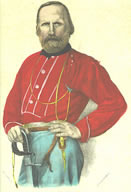 Of
course, the history of Marsala continues through modern times.
In fact, in 1860, it was here that Giuseppe Garibaldi,
“The Hero of Two Worlds,” landed with his famous
“I Mille,” or “The Thousand”,
and began the revolution to unify Italy. It is said that
he rode a white horse that he named after the city. Of
course, the history of Marsala continues through modern times.
In fact, in 1860, it was here that Giuseppe Garibaldi,
“The Hero of Two Worlds,” landed with his famous
“I Mille,” or “The Thousand”,
and began the revolution to unify Italy. It is said that
he rode a white horse that he named after the city.
In later years, Garibaldi shared a home in New York with
hid friend and compatriot, Antonio Meucci, the famous inventor.
The statue erected in his honor still stands today in Washington
Square Park. He and his “red shirts” can are
also paid tribute on the (pre-Euro) thousand lire bill. |
|
|
|
|
|
|
|
|
|
|
|
|
|
|
Florio,
Woodhouse, Nelson, and Whitaker
Even a brief history of Marsala would not be complete without
mentioning John Woodhouse and Vincenzo Florio. Woodhouse landed
at Marsala in 1773, and ‘discovered’ that
the local wine produced in the area, and aged in wooden barrels,
tasted similar to the Portuguese “Porto”. Eventually,
this fortified wine found such success in England that he returned
to Sicily in 1796, and became a pioneer in the mass production
and commercialization of Marsala wine.
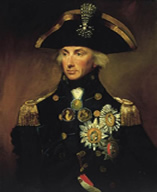 The
legendary Admiral Horatio Nelson, who defeated
Napoleon Bonaparte in the Battle of ther Nile, spent a great
deal of time in the northwest region of Sicily, between Palermo
and Marsala. It was he who introduced Marsala wine to the British
Navy as an alternative to Port, and even suggested a regimen
of one glass per day. The
legendary Admiral Horatio Nelson, who defeated
Napoleon Bonaparte in the Battle of ther Nile, spent a great
deal of time in the northwest region of Sicily, between Palermo
and Marsala. It was he who introduced Marsala wine to the British
Navy as an alternative to Port, and even suggested a regimen
of one glass per day.
Joseph Whitaker, a young English entrepreneur
and archeologist, inherited a vast vineyard in Marsala, upon
which he founded a “baglio,” or typical Sicilian
wine estate. From this baglio, Whitaker made a fortune exporting
wine to the U.S. and England around the turn of the 19th century
In his later years, Whitaker is known to have bought the island
of Mozia, where he founded an archeological museum and published
important studies of Tunisian birds. However, his influence
on Marsala’s development and economy, even today, cannot
be overstated.
In the beginning of the 19th Century, Vincenzo Florio,
an entrepreneur from Palermo, purchased the Woodhouse wine industry
and set out to create his very own vintage, with a more exclusive
breed of grapes. During that time, often referred to as la
belle epoque, the Florio family were considered one the
richest of Italy . They also owned one of the first tuna canneries,
from the tonnara (fisheries) of the Egadi Islands,
as well as a large fishing vessel that was one of the first
to bring tuna from Marsala across the Atlantic to New York.
Although the family retired from industry after World War I,
their name remains one of the largest and most recognizable
in Marsala wine production. |
|
|
|
|
|
|
|
|
|
|
|
|
|
|
|
Monuments
and Museums
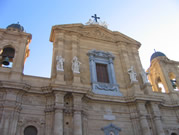 Walking
from the Capo Lilibeo, one passes through
a grand Renaissance arch, the Porta Nuova,
and enters the “pedestrian zone,” surrounding
the historic center. The road leads to elegant streets lines
with stately buildings all the way to the Piazza della Repubblica,
where one comes face-to-face with the impressive Cathedral.
On the opposite end of the square, one finds the Palazzo
Senatorio (Senatorial Palace), which today serves
as the town hall. Walking
from the Capo Lilibeo, one passes through
a grand Renaissance arch, the Porta Nuova,
and enters the “pedestrian zone,” surrounding
the historic center. The road leads to elegant streets lines
with stately buildings all the way to the Piazza della Repubblica,
where one comes face-to-face with the impressive Cathedral.
On the opposite end of the square, one finds the Palazzo
Senatorio (Senatorial Palace), which today serves
as the town hall.
The Cathedral of Marsala, located in the heart of the city,
is dedicated to St. Thomas of Canterbury. Originally built
by the Normans, the façade of the church was only
completed in 1956, with the help of donations from emigrants
of the city. The Cathedral boasts sculptures by
artists of the Gagini school.
Museo
Regionale Baglio Anselmi
Via Lungomare Boero
Tel: +39.0923.952.535;
Visiting schedule:9:30am-1:30pm,Mon-Wed.4:30pm-6:30pm,Thur-Sun.
Admission: 2 €
Along the Lungomare Boeo lies one of the most extraordinary
remains of the Phoenecian civilization, nearly extinguished
by the Romans during the Punic wars. Marsala’s finest
treasure is the Carthaginian “Liburna,” a reconstructed
warship 35 meters long, thought to have been part of the Roman
fleet attack of 241 BC during “the Battle of the Egadi”.
Museo
degli Arazzi Fiamminghi
Via Giuseppe Garraffa, 57
Tel: +39.0923.712.903
Visiting schedule: 9.00am-1.00pm /4.00pm-6.00pm
.Tue-Sunday.
Admission:2 €
The name of this museum, which translates as “The Museum
of Flemish Tapestries,” reflects its contents—a
display of eight magnificent Flemish tapestries sewn in Brussels
(1530-1550) and gifted by the Spanish King Felipe II to the
archbishop of Messina, Antonio Lombardo (1523-1595), who
was born in Marsala. The tapestries depict the Roman capture
of Jerusalem from the Saracens.
Complesso
Monumentale San Pietro
Via Ludovico Anselmi Correale
Tel: +39.0923.718.741
Visiting schedule: 9.00am-1.00pm / 4.00pm-8.00pm.
Admission: free
A former Benedictine monastery of the XVI century, the Monumental
Complex is a beautifully restored building that holds a permanent
exhibition on Giuseppe Garibaldi. An archeological section
includes objects from Lilibeo’s necropolis and an area
dedicated to Sicilian folk tradition.
Convento
del Carmine
Piazza del Carmine
Tel:+39.0923.711.631
Visiting schedule: 10.00am-1.00pm / 5.00pm-7.00pm.
Tue-Sunday. Admission: free
The convent building, dated AD 1115 was given to the Carmelite
order of nuns by Adelaide, the widow of Roger I, the Norman
King of Sicily. After years of neglect, the convent, itself
a work of art, has recently been restored and returned to
its former glory, and is today an art gallery. |
|
|
|
|
|
|
|
|
|
|
|
|
|
|
|
Events
Holy Thursday Procession
Thursday before Easter Sunday (March or April),
Annually.
Easter, the most important holiday of the Catholic Church,
is a widely celebrated occasion in Sicily. Among the numerous
traditional and religious events and processions of Holy Week,
the “Marsalese”
is one of the most important. Many participants, actors and
children dressed in colorful costumes representing saints and
other religious figures, depict the events leading up to the
crucifiction of Jesus Christ.
Madonna
della Cava
The patron saint of the city, Madonna della Cava has her sanctuary
in a grotto in the Porticella neighborhood, where her image
was discovered inside well during the 6th century. The Madonna
is celebrated each year with a procession of the faithful
on the 19th of January.
San
Giuseppe
Each year, on the 19th of March, a poor family
is selected to symbolize the Holy Family- Joseph, Mary, and
baby Jesus. The family is invited to a banquet on an open-air
altar, perched above the Marsalese meadows. The banquet is
carefully choreographed to represent the nourishment and participation
of the common people.
San
Giovanni
This compatriot of the city is celebrated on the 24th
of June each year, with a demonstration that combines
the sacred with the profane. The faithful visit the well of
Sybil, where they pray for happiness and fortune.
Manifestazioni
Garibaldine
In May of each year, the city of Marsala reenacts Garibaldi’s
disembarkment, with demonstrations and exhibits over the course
of a weekend, and sometimes as long as a week. The celebrations
include conventions and forums on the themes of the Risorgimento,
or “Resurgence”, guided tours, and food samples
from that era.
Marsala
Wine Festival
The international show of sweet and distilled wines and liquors
takes place here every two years at mid-October, and includes
various activities. The festivities include laboratories for
tasting, regional delicacy displays, conventions, guided tours,
and excursions.
Summer
Together: Estate Insieme
Each year, from July through September, a full itinerary
of community events take place throughout the center of the
city. Events include open-air cinema within the breathtaking
St. Peter’s monument complex; musical, theater and
cabaret performances; and traditional folk and cultural activities.
The combination of colors, lights, and life renders the city
a truly magnificent scene, allowing for entire evenings of
carefree enjoyment and community participation. |
|
|
|
|
|
|
|
|
|
|
|
|
|
|
|
Shopping
Marsala’s open-air fresh produce market, Piazza dell’Addolorata |
|
|
|
|
|
|
|
|
|
|
|
|
|
|
|
Mozia
Mozia,
or Motya, is the only surviving Carthaginian site (XVII century
BC). Located just 5 km north of Marsala following the coastal
road SP 21, the site can be found on the Isle of San Pantaleo-
one of the small islands in “Lo
Stagnone,” a lagoon and nature reserve among the salt
flats between Marsala and Trapani.
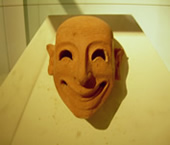 To
get there, you can take the ferry, stationed at an old windmill,
which leaves for the island every 10 min. (9am-7pm) If you
are adventurous, you can walk- the water between the mainland
and the island of San Pantaleo is only 1 meter deep. To
get there, you can take the ferry, stationed at an old windmill,
which leaves for the island every 10 min. (9am-7pm) If you
are adventurous, you can walk- the water between the mainland
and the island of San Pantaleo is only 1 meter deep.
The Island of San Pantaleo was re-discovered by Joseph Whitaker,
a highly regarded archeologist and English entrepreneur, in
1913. He eventually became a successful vintner and trader.
Upon his retirement, Whitaker bought the island of San Pantaleo,
and built a Villa.
He ultimately spent decades digging and assembling a unique
collection of Phoenician artifacts, including an ancient
port and a dry dock. The Villa he constructed, known as “Villa
Whitaker,” is now a Museum owned by the Whitaker Foundation.
The main treasure at Villa Whitaker is a masterpiece of ancient
Greek art, “the Giovinetto di Mozia”. Discovered
on the island in 1979, the Giovinetto is one of the greatest
surviving Greek sculptures in the world. Carved in the early
5th century BC of Anatolian marble (Turkey), the statue of
the “young boy” stands with one hand on his hip,
and is dressed in a sensual long Phoenician-style tunic, his
muscular, yet exquisitely graceful body implies a sensuality
often compared to other Greek statues of the same period.
If you love ancient art, Mozia is a “must”.
The Stagnone Islands
and The Windmills
Continue driving along the coast on the SS115, and you will
come across one of the most attractive and 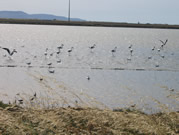 picturesque
spots in all of Sicily- the “saline,” or salt
marshes, and the Stagnone Islands Natural Reserve. Take in
the blond landscape with shallow pools and frothy mounds of
salt beneath the “mulini a vento,” or windmills,
used for draining water from the basins where salt collects.
The marine salt from these marshes is considered some the
best in Italy and has been exported as far as Norway since
the 17th century. picturesque
spots in all of Sicily- the “saline,” or salt
marshes, and the Stagnone Islands Natural Reserve. Take in
the blond landscape with shallow pools and frothy mounds of
salt beneath the “mulini a vento,” or windmills,
used for draining water from the basins where salt collects.
The marine salt from these marshes is considered some the
best in Italy and has been exported as far as Norway since
the 17th century.
While the wooden windmills using Archimedes screws to move
the water are mostly decorative, they are truly picturesque
“industrial monuments’ along the waters of the
lagoon, and some are also accessible to the public as museums
or restaurants. Despite the fact that the salt business is
not as extensive as it once was (today, the area is a natural
reserve, well-protected from industrial pollution and indiscriminate
building construction), it is certainly worth visting for
the sheer beauty of the scene, as well as the opportunity
for some excellent bird watching.
The
Ocean Way
For
many years, Marsala’s coast has been considered
one of the purest, cleanest, and most beautiful in all of
Europe. In fact, the city of Marsala can count the “Bandiera
Blu,” or European “Blue Ribbon” for ocean
purity 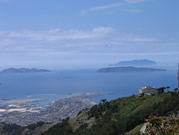 and
beach facilities, among its prizes. Its coastline extends
south for ten kilometers toward the District of Petrosino;
to the north, it travels approximately 15 kilometers to Birgi-Marausa.
The beaches are predominantly sandy, several of which are
serviced with showers and umbrella rentals. and
beach facilities, among its prizes. Its coastline extends
south for ten kilometers toward the District of Petrosino;
to the north, it travels approximately 15 kilometers to Birgi-Marausa.
The beaches are predominantly sandy, several of which are
serviced with showers and umbrella rentals.
“La Via del Mare,” or, ”The Ocean Way”,
is the head of the turistic port, with nearly 200 boat slips.
There is also a commercial port, where a fleet of boats is dedicated to the fishing
of tuna and swordfish.
From the Cape of Boeo, the westernmost point of Italy, one
can catch a glimpse of the Egadi Islands (Favignana, Levanzo,
and Marettimo), reachable by hydrofoil. This is also the
place to come for water sports. From here, one can enjoy
the many water activities offered all year round, including
canoeing, surfing, kite flying, and windsurfing, for which
the breezy climate is well-suited. The low tide “uncovers”
and renders passable the submerged road that once connected
Mozia to the Birgi necropolis. An additional point of interest
is the antique fish market, which can be found in the Spanish
quarter, a short walk from the Port of Garibaldi, in the
heart of the historic center of the city.
Wineries
(see also FOOD AND WINE)
There are several wineries in and around Marsala that one
can visit. Many of these picturesque “Bagli,”
or traditional Sicilian wine estates, were built over several
generations, and still produce wine using old-fashioned,
time-honored techniques. Guided tours and tasting rooms are
often available.
We do not have precise information regarding wineries at
this time. We will publish all necessary facts and useful
tips for your trip through Marsala’s wine country just
as soon as possible. |
|
|
|
|
|
|
|
|
|
|
|
|
|
|
|
Practical
info
To call from abroad you will need to dial:
+39 (Italy) 0923 (Area code) + Telephone number.
From Italy you need to dial “00”
+ your country code + desired number
(es. 00.+1 .212. to New York)
You can also rent a cellular phone while you are here, or bring
your own a tri- or quad-band to be reached.
You can buy prepaid phone cards (schede prepagate) you at the
newspaper stands and tobacconist shops. Postage stamps are available
here, as well.
Banks
and ATM's
Bank Hours of Operation: Monday to Friday 9.00am-4.00pm (with
a one-hour mid-day break) , closed Saturdays, Sundays, and
Holidays.
ATM machines are available 24h per day, however they are located
only at banks, and mostly in the city center.
Credit cards are accepted in shops, hotels,
restaurant and gas stations.
Shopping
(see also WHERE)
Business hours: 9.00am-1.00pm; 3.30pm 8.00pm Mon-Saturday.
Some shops, though, may also be open on Sunday, depending
on the business and the season (and often open later in the
summer months).
Money
The currency is the Euro €, issued
in notes (5 €, 10 €,20 €, 50 €, 100 €,
500 €) and in coins (1 cent, 2 cents, 5 cents,10 cents,
20 cents, 50 cents, 1 €, 2€).
Money can be changed at the airports, money exchange bureaus,
and at the post office. Traveler’s checks can be changed
by most hotels and resorts.
Emergency
Emergency health service 118 (toll free#)
Pharmacies can be identified by a green (or sometimes red)
cross, and always have a doctor on duty. They are generally
closed in the evenings, though most large cities have at least
one pharmacy that remains open 24 hours. When closed, pharmacies
post the name and address of the pharmacy on duty and a list
of doctors for emergency.
Police
(first aid)
Call 113 or 112 (toll
free#) from any telephone.
Municipal
Police
Via Ernesto Del Giudice
tel. 0923.993100 - 723224
Tourist
Information
Tourist office Tel: 0923.714097
via XI Maggio, 100; 8.00am-2.00pm 3.00pm-8.00pm Mon-Sat 9.00am-12.00
Sun.
Information booths are available along “Lungomare
Boero” and in the city center. |
|
|
|
|
|
|
|
|
|
|
|
|
|
|
|
|
|
|
|
|
english
translation by VALERIA R. CASALE |
|
|
|
|
|
|
|
|
|
|
|
|
|
|
|
|

